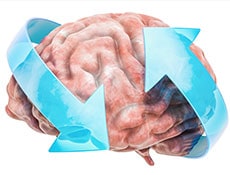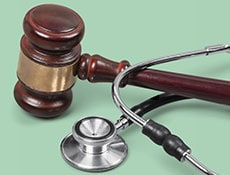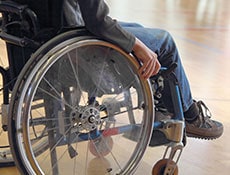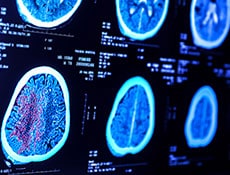Birth injuries can sometimes have devastating consequences. A diagnosis of cerebral palsy is arguably one of the worst possible outcomes for a child that is injured during childbirth. Cerebral palsy is a lifelong disability that can result from minutes of oxygen deprivation during birth.
Our Maryland cerebral palsy lawyers have seen firsthand how this condition can lead to substantial medical expenses and make it difficult, and sometimes, impossible for a child to live a normal life. In a significant number of cases, cerebral palsy is caused by medical malpractice.
What is Cerebral Palsy?
 Cerebral palsy is a group of related disorders in which the brain is not able to control and manage ordinary movement and coordination of the muscles in the body.
Cerebral palsy is a group of related disorders in which the brain is not able to control and manage ordinary movement and coordination of the muscles in the body.
What Causes Cerebral Palsy?
 Cerebral palsy is caused by damage to a baby’s developing brain from oxygen deprivation during pregnancy or childbirth. The injury leaves the brain unable to control body movements.
Cerebral palsy is caused by damage to a baby’s developing brain from oxygen deprivation during pregnancy or childbirth. The injury leaves the brain unable to control body movements.
Value of CP Malpractice Cases
 Malpractice litigation is a viable source of financial assistance for cerebral palsy. Get insight from our attorneys on the potential value of cerebral palsy malpractice cases at settlement or trial.
Malpractice litigation is a viable source of financial assistance for cerebral palsy. Get insight from our attorneys on the potential value of cerebral palsy malpractice cases at settlement or trial.
Symptoms of Cerebral Palsy
 The specific symptoms of cerebral palsy vary significantly depending on the CP subtype and the severity of each individual case.
The specific symptoms of cerebral palsy vary significantly depending on the CP subtype and the severity of each individual case.
Treatment for Cerebral Palsy
 Cerebral palsy cannot be cured but its symptoms can be effectively managed with physical therapy, medications, and other treatment options.
Cerebral palsy cannot be cured but its symptoms can be effectively managed with physical therapy, medications, and other treatment options.
Cerebral Palsy Financial Assistance
 Having a child with cerebral palsy can have major financial implications, but public and private means of assistance are available.
Having a child with cerebral palsy can have major financial implications, but public and private means of assistance are available.
Cerebral Palsy and Malpractice
 Medical error or negligence during labor and delivery or in prenatal care are the primary causes of cerebral palsy that lead to medical malpractice litigation.
Medical error or negligence during labor and delivery or in prenatal care are the primary causes of cerebral palsy that lead to medical malpractice litigation.
Types of Cerebral Palsy
 There are 4 different recognized types of cerebral palsy: spastic, dyskinetic, ataxic, and mixed. Each subtype has its own unique symptoms and characteristics.
There are 4 different recognized types of cerebral palsy: spastic, dyskinetic, ataxic, and mixed. Each subtype has its own unique symptoms and characteristics.
Cerebral Palsy Statistics
Cerebral palsy is the leading cause of childhood disability in the world. This page summarizes the available data and statistics on cerebral palsy.
Education Programs for Cerebral Palsy
Kids with cerebral palsy may have unique education needs to accommodate their learning or physical disabilities. Learn about public programs that provide a host of educational support services to children with cerebral palsy to put your child on the best possible path to a good education.
Cerebral Palsy
Cerebral palsy is not a disease. It is a group of non-progressive conditions arising from an injury to the developing brain. CP affects approximately 2 in 1000 live births. It is called the most common motor disorder of childhood.
Cerebral palsy that causes lifelong injury and leads to medical malpractice lawsuits are much less common, affecting 1 out of approximately 12,000 live births. Incidence rates of cerebral palsy have fallen in the last decade. Obstetricians are getting smarter. But there are still too many tragedies that could have been avoided.
Children with CP experience movement and posture disturbances, including muscle weakness, reduced coordination, epilepsy, disturbances of sensation, cognition, perception, behavior, communication, and secondary musculoskeletal problems.
It is important to recognize that cerebral palsy does not always result in a profound handicap. But often has significant demands on the family, the risk of depression, and high costs associated with each case of negligent care.
Our cerebral palsy attorneys have seen firsthand the devastation birth injuries can bring to a family. Does a large medical malpractice settlement or verdict solve the problem? It does not. But money absolutely makes it easier to manage, today and for the rest of that child’s life.
Causes of Cerebral Palsy
Many children with cerebral palsy have a congenital malformation of the brain. This means that the abnormality existed at birth and was not caused by factors occurring during the birthing process. (This also means there is no viable birth injury claim.) Cerebral palsy may also occur due to brain damage sustained during labor and delivery, often resulting from a lack of oxygen to the brain or trauma experienced.
This type of damage may be due to the medical malpractice of those involved in delivering the baby. Recently, infection has been shown to cause cerebral palsy. This is especially true in cases where there are no other causes of cerebral palsy in term babies.
In a study published in the American Journal of Obstetrics and Gynecology, researchers reviewed adverse birth events and possible associations with the development of cerebral palsy. The researchers identified six labor and delivery process events that could lead to cerebral palsy:
- placental abruption
- uterine rupture during labor
- fetal distress (non-reassuring heart rate)
- cord prolapse
- asphyxia
- birth trauma
Determining the cause of cerebral palsy often takes years. However, many signs and symptoms are present and prominent following birth and in early childhood. In cases where cerebral palsy is a result of intrapartum damage, neonatal encephalopathy is present.
Neonatal encephalopathy is defined as abnormal neurological findings presenting within 12–24 hours after birth in conjunction with signs of cortical dysfunction, including lethargy, stupor and in severe cases, seizures.
Signs of CP that may be present in early life include difficulties breathing, low APGAR score, significantly missing developmental milestones, abnormal bone growth, difficulty or inability to walk, spasticity, and lack of muscle tone.
There is currently no cure for cerebral palsy. But many affected CP victims can lead productive and satisfying lives due to advances made in modern therapy and technology. Physical therapy is used in children with cerebral palsy to improve overall functional outcomes by reducing neurologic impairments, increasing physical strength and preventing the development of secondary impairments.
Many intervention strategies focus on the reduction of spasticity, which is one of the most notable impairments associated with cerebral palsy. Researchers are also working on determining the role of cord blood therapy for treating cerebral palsy.
This is exciting. As these advances continue, so will the percentage of cerebral palsy victims who can rely on medicines and other treatment modalities to manage the symptoms of cerebral palsy and live more functional lives.
Cerebral Palsy and Medical Malpractice
The exact cause and pathogenesis of cerebral palsy are complex and not fully understood, involving a myriad of factors. Cerebral palsy can result from prenatal, perinatal, or postnatal conditions, including genetic mutations, maternal infections, preterm birth, and complications during labor and delivery.
Cerebral palsy defense lawyers often exploit this complexity to argue that cerebral palsy was inevitable, regardless of the quality of medical care provided. They are assisted by doctors desperate to prove cerebral palsy is not caused by malpractice. Every time you turn your head, there is a new study that suggests that CP is caused by some other factor than malpractice. But the idea that suboptimal care cannot cause CP is ridiculous.
How to Counter This Argument
To counter these arguments effectively, victims’ cerebral palsy malpractice lawyers must demonstrate that the medical team failed to act on specific warning signs, such as abnormal fetal heart rate patterns or insufficient monitoring during labor.
This requires detailed medical records, expert testimonies, and a clear timeline of events to establish that negligence, rather than uncontrollable factors, led to the condition.
Specific Issues Related to Cerebral Palsy Malpractice
Let’s look at some of the specific issues that are a battleground in cerebral palsy malpractice lawsuits.
Fetal Heart Rate Monitoring
The absence of fetal heart rate accelerations or the presence of other abnormalities in the FHR can be an early warning sign for obstetricians. Fetal heart rate accelerations are defined as abrupt increases in the FHR above the baseline, with the onset to peak of the acceleration occurring in less than 30 seconds and lasting less than 2 minutes. These accelerations typically indicate a healthy, responsive fetus.
Fetal Admission Test
In addition to fetal heart rate accelerations, a cerebral palsy lawyer scrutinizes various components of the fetal admission test to identify potential medical malpractice. These components are critical in assessing the fetus’s health and identifying any signs of distress that may indicate the need for intervention. Key monitoring techniques include:
- Doppler Ultrasound Transducer: This device measures the fetal heart rate, providing continuous monitoring of the baby’s heartbeat to detect any abnormalities that might indicate fetal distress.
- Uterine Contractions: By assessing the strength and frequency of uterine contractions, doctors can determine if the labor process is progressing normally or if there are complications that could compromise the fetus’s oxygen supply.
- Sound-Provoked Fetal Movement: This test evaluates the fetus’s responsiveness to auditory stimuli, which is an indicator of neurological function and overall well-being.
- Fetal Breathing Movements: Observing fetal breathing movements helps to assess the fetus’s lung development and readiness for life outside the womb, as well as overall fetal health.
- Amniotic Fluid Volume: Measuring the volume of amniotic fluid is essential, as it reflects the adequacy of the fetal environment. Both too little and too much amniotic fluid can indicate potential problems that need to be addressed.
By examining these tests and their results, a cerebral palsy attorney can pinpoint whether there were missed signs or inadequate responses to fetal distress that could constitute medical malpractice.
If these monitoring techniques were not properly conducted or interpreted, and if these failures led to delayed or inappropriate medical intervention, they can argue that such negligence contributed to the development of cerebral palsy. This detailed analysis, supported by medical records and expert testimonies, forms the foundation of a strong legal case for compensation.
Interpreting Signs and Treatment
Obstetricians must accurately interpret these tests and identify potential warning signs, even if initial tests suggest the fetus is neurologically intact. Too often, they stop at “the child seems okay.” A thorough understanding of these indicators is essential to prevent adverse outcomes that could result in conditions like cerebral palsy. Medical professionals – both the doctors and nurses – are responsible for continuously monitoring and treating both the mother and the fetus, ensuring timely and appropriate interventions when abnormalities are detected.
Statute of Limitations in Cerebral Palsy Cases
The statute of limitations in a cerebral palsy case varies by state. In Maryland, the statute of limitations in a cerebral palsy case is complicated. The child’s claim is cut and dry. The child has a claim before his or her 21st birthday.
The parents also have a claim in birth injury cases for, among other things, medical expenses. In one technical sense, there is an obligation to bring this case within three years. But Maryland courts have relaxed this requirement in many cases (Garay and Pepper).
Maryland Cerebral Palsy Lawyers
If you believe your child has cerebral palsy as a result of medical malpractice, our attorneys will do everything we can to help you and to get to the truth.
Call to talk directly to a Maryland cerebral palsy attorney at 800-553-8082 or get a free online consultation.
More Information About Cerebral Palsy Lawsuits
- More on CP Claims
- Types of Birth Injuries During Pregnancy
- Medical Malpractice Frequently Asked Questions
- What you need to do to get a malpractice case going
- Does My Child Have Cerebral Palsy?
- CP Life Expectancy
- Types of Wheelchairs for Children With Cerebral Palsy
- Cerebral Palsy Statistics and Facts 2023
- Types of Cerebral Palsy
- Cerebral Palsy FAQ
 Medical Malpractice
Medical Malpractice





